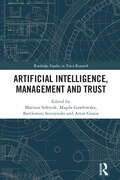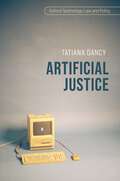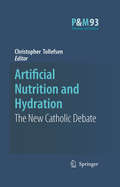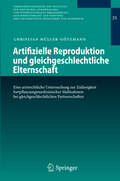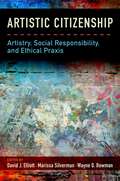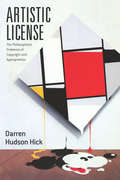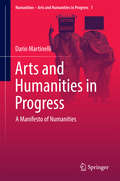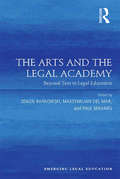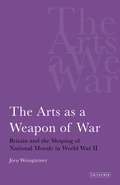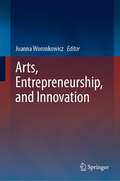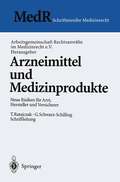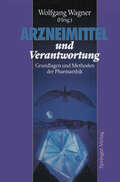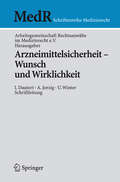- Table View
- List View
Artificial Intelligence, Management and Trust (Routledge Studies in Trust Research)
by Mariusz So 322 Tysik Magda Gaw 322 Owska Bartlomiej Sniezynski Artur GuniaThe main challenge related to the development of artificial intelligence (AI) is to establish harmonious human-AI relations, necessary for the proper use of its potential. AI will eventually transform many businesses and industries; its pace of development is influenced by the lack of trust on the part of society. AI autonomous decision-making is still in its infancy, but use cases are evolving at an ever-faster pace. Over time, AI will be responsible for making more decisions, and those decisions will be of greater importance. The monograph aims to comprehensively describe AI technology in three aspects: organizational, psychological, and technological in the context of the increasingly bold use of this technology in management. Recognizing the differences between trust in people and AI agents and identifying the key psychological factors that determine the development of trust in AI is crucial for the development of modern Industry 4.0 organizations. So far, little is known about trust in human-AI relationships and almost nothing about the psychological mechanisms involved. The monograph will contribute to a better understanding of how trust is built between people and AI agents, what makes AI agents trustworthy, and how their morality is assessed. It will therefore be of interest to researchers, academics, practitioners, and advanced students with an interest in trust research, management of technology and innovation, and organizational management.
Artificial Intelligence, Management and Trust (Routledge Studies in Trust Research)
by Mariusz Sołtysik Magda Gawłowska Bartlomiej Sniezynski Artur GuniaThe main challenge related to the development of artificial intelligence (AI) is to establish harmonious human-AI relations, necessary for the proper use of its potential. AI will eventually transform many businesses and industries; its pace of development is influenced by the lack of trust on the part of society. AI autonomous decision-making is still in its infancy, but use cases are evolving at an ever-faster pace. Over time, AI will be responsible for making more decisions, and those decisions will be of greater importance. The monograph aims to comprehensively describe AI technology in three aspects: organizational, psychological, and technological in the context of the increasingly bold use of this technology in management. Recognizing the differences between trust in people and AI agents and identifying the key psychological factors that determine the development of trust in AI is crucial for the development of modern Industry 4.0 organizations. So far, little is known about trust in human-AI relationships and almost nothing about the psychological mechanisms involved. The monograph will contribute to a better understanding of how trust is built between people and AI agents, what makes AI agents trustworthy, and how their morality is assessed. It will therefore be of interest to researchers, academics, practitioners, and advanced students with an interest in trust research, management of technology and innovation, and organizational management.
Artificial Intelligence, Social Harms and Human Rights (Critical Criminological Perspectives)
by Aleš Završnik Katja SimončičThis book critically explores how and to what extent artificial intelligence (AI) can infringe human rights and/or lead to socially harmful consequences and how to avoid these. The European Union has outlined how it will use big data, machine learning, and AI to tackle a number of inherently social problems, including poverty, climate change, social inequality and criminality. The contributors of this book argue that the developments in AI must take place in an appropriate legal and ethical framework and they make recommendations to ensure that harm and human rights violations are avoided. The book is split into two parts: the first addresses human rights violations and harms that may occur in relation to AI in different domains (e.g. border control, surveillance, facial recognition) and the second part offers recommendations to address these issues. It draws on interdisciplinary research and speaks to policy-makers and criminologists, sociologists, scholars in STS studies, security studies scholars and legal scholars.
Artificial Justice (Oxford Technology Law and Policy)
by Tatiana DancyImagine that Eric, a young man, has been convicted of a gang-related crime: he was found by police at the scene of a robbery carried out by his friends. The sentencing judge now needs to make a decision. Not knowing whether Eric poses a risk to the public, she turns to an algorithmic risk assessment - a set of rules, developed on the basis of correlations between individual characteristics and criminal activity, which predicts the likelihood of recidivism. Eric is a conscientious citizen, who has never before been in trouble with the law. However, he was raised in foster care, in an area with high rates of crime, poverty, and residential instability- facts to which the algorithm attributes a high risk score. The judge recommends a sentence of the maximum possible duration, with extended post-release supervision. Why does this matter? The answer most often given is that it matters because of inequality, captured through the language of 'bias' or 'discrimination': the effect of using algorithms can be to exacerbate unjustified differences between people, on the basis of considerations such as race, sex, or socio-economic circumstance. Using a diverse set of case studies, and making clear policy recommendations along the way, Artificial Justice unpacks the reasons that we might have to object to the use of statistical algorithms to allocate the burdens of policy decisions. It argues that these reasons extend beyond egalitarian concerns. Importantly, they include reasons that stem from the value of individual choice - of having the chance to affect what happens to us by choosing appropriately and being equipped to exercise those choices well. The book explores the substantive reasons that contribute to a picture of what's at stake for individuals when we use statistical algorithms to make decisions about how to treat others, and makes robust policy recommendations about the scope and nature of human-algorithm interaction. Artificial Justice is a compelling and accessible text, which offers a great deal to a wide and interdisciplinary audience of academics, students, and those otherwise interested in learning about algorithmic justice.
Artificial Justice (Oxford Technology Law and Policy)
by Tatiana DancyImagine that Eric, a young man, has been convicted of a gang-related crime: he was found by police at the scene of a robbery carried out by his friends. The sentencing judge now needs to make a decision. Not knowing whether Eric poses a risk to the public, she turns to an algorithmic risk assessment - a set of rules, developed on the basis of correlations between individual characteristics and criminal activity, which predicts the likelihood of recidivism. Eric is a conscientious citizen, who has never before been in trouble with the law. However, he was raised in foster care, in an area with high rates of crime, poverty, and residential instability- facts to which the algorithm attributes a high risk score. The judge recommends a sentence of the maximum possible duration, with extended post-release supervision. Why does this matter? The answer most often given is that it matters because of inequality, captured through the language of 'bias' or 'discrimination': the effect of using algorithms can be to exacerbate unjustified differences between people, on the basis of considerations such as race, sex, or socio-economic circumstance. Using a diverse set of case studies, and making clear policy recommendations along the way, Artificial Justice unpacks the reasons that we might have to object to the use of statistical algorithms to allocate the burdens of policy decisions. It argues that these reasons extend beyond egalitarian concerns. Importantly, they include reasons that stem from the value of individual choice - of having the chance to affect what happens to us by choosing appropriately and being equipped to exercise those choices well. The book explores the substantive reasons that contribute to a picture of what's at stake for individuals when we use statistical algorithms to make decisions about how to treat others, and makes robust policy recommendations about the scope and nature of human-algorithm interaction. Artificial Justice is a compelling and accessible text, which offers a great deal to a wide and interdisciplinary audience of academics, students, and those otherwise interested in learning about algorithmic justice.
Artificial Nutrition and Hydration: The New Catholic Debate (Philosophy and Medicine #93)
by Christopher TollefsenPope John Paul II surprised much of the medical world in 2004 with his strongly worded statement insisting that patients in a persistent vegetative state should be provided with nutrition and hydration. This collection of essays featuring some of the most prominent Catholic bioethicists addresses the Pope’s statements, the moral issues surrounding artificial feeding and hydration, the refusal of treatment, and the ethics of care for those at the end of life.
Artifizielle Reproduktion und gleichgeschlechtliche Elternschaft: Eine arztrechtliche Untersuchung zur Zulässigkeit fortpflanzungsmedizinischer Maßnahmen bei gleichgeschlechtlichen Partnerschaften (Veröffentlichungen des Instituts für Deutsches, Europäisches und Internationales Medizinrecht, Gesundheitsrecht und Bioethik der Universitäten Heidelberg und Mannheim #35)
by Christian Müller-GötzmannDie moderne Reproduktionsmedizin wird zunehmend auch von gleichgeschlechtlichen Paaren genutzt. Der Autor beschäftigt sich mit den soziologischen, kultur- und rechtsgeschichtlichen sowie sexualwissenschaftlichen und entwicklungspsychologischen Fragen der gleichgeschlechtlichen Elternschaft und analysiert die Rechtslage. Nach einer kritischen Bestandsaufnahme des Embryonenschutzgesetzes und Adoptionsrechts sowie des ärztlichen Standesrechts werden familienrechtliche Probleme, die Bewertung ärztlichen Handelns und Fragen der Kostentragung diskutiert.
Artistic Citizenship: Artistry, Social Responsibility, and Ethical Praxis
by David J. Elliott, Marissa Silverman and Wayne D. BowmanThis first-of-its-kind compendium unites perspectives from artists, scholars, arts educators, policymakers, and activists to investigate the complex system of values surrounding artistic-educational endeavors. Addressing a range of artistic domains-including music, dance, theater, visual arts, film, and poetry-contributors explore and critique the conventions that govern our interactions with these practices. Artistic Citizenship focuses on the social responsibilities and functions of amateur and professional artists and examines ethical issues that are conventionally dismissed in discourses on these topics. The questions this book addresses include: How does the concept of citizenship relate to the arts? What sociocultural, political, environmental, and gendered "goods" can artistic engagements create for people worldwide? Do particular artistic endeavors have distinctive potentials for nurturing artistic citizenship? What are the most effective strategies in the arts to institute change and/or resist local, national, and world problems? What obligations do artists and consumers of art have to facilitate relationships between the arts and citizenship? How can artistic activities contribute to the eradication of adverse 'ism's? A substantial accompanying website features video clips of "artivism" in action, videotaped interviews with scholars and practitioners working in a variety of spaces and places, a blog, and supplementary resources about existing and emerging initiatives. Thoroughly researched and engagingly written, Artistic Citizenship is an essential text for artists, scholars, policymakers, educators, and students.
Artistic Citizenship: Artistry, Social Responsibility, and Ethical Praxis
This first-of-its-kind compendium unites perspectives from artists, scholars, arts educators, policymakers, and activists to investigate the complex system of values surrounding artistic-educational endeavors. Addressing a range of artistic domains-including music, dance, theater, visual arts, film, and poetry-contributors explore and critique the conventions that govern our interactions with these practices. Artistic Citizenship focuses on the social responsibilities and functions of amateur and professional artists and examines ethical issues that are conventionally dismissed in discourses on these topics. The questions this book addresses include: How does the concept of citizenship relate to the arts? What sociocultural, political, environmental, and gendered "goods" can artistic engagements create for people worldwide? Do particular artistic endeavors have distinctive potentials for nurturing artistic citizenship? What are the most effective strategies in the arts to institute change and/or resist local, national, and world problems? What obligations do artists and consumers of art have to facilitate relationships between the arts and citizenship? How can artistic activities contribute to the eradication of adverse 'ism's? A substantial accompanying website features video clips of "artivism" in action, videotaped interviews with scholars and practitioners working in a variety of spaces and places, a blog, and supplementary resources about existing and emerging initiatives. Thoroughly researched and engagingly written, Artistic Citizenship is an essential text for artists, scholars, policymakers, educators, and students.
Artistic Creation and Ethical Criticism (Thinking Art)
by Ted NannicelliArtistic Creation and Ethical Criticism, a study in philosophical aesthetics, investigates an idea that underpins the ethical criticism of art but that is rarely acknowledged and poorly understood - namely, that the ethical criticism of art involves judgments not only of the attitudes a work endorses or solicits, but of what artists do to create the work. The book pioneers an innovative production-oriented approach to the study of the ethical criticism of art - one that will provide a detailed philosophical account of the intersection of ethics and artistic creation as well as conceptual tools that can guide future philosophizing and criticism. Ted Nannicelli offers three arguments concerning the ethical criticism of art. First, he argues that judgments of an artwork's ethical value are already often made in terms of how it was created, and examines why some art forms more readily lend themselves to this form of ethical appraisal than others. He then asserts that production-oriented evaluations of artworks are less contested than other sorts of ethical criticism and so lead to certain practical consequences-from censure, dismissal, and prosecution to shifts in policy and even legislation. Finally, Nannicelli defends the production-oriented approach, arguing that it is not only tacit in many of our art appreciative practices, but is in fact rationally warranted. There are many cases in which we should ethically critique artworks in terms of how they are created because this approach handles cases that other approaches cannot and results in plausible judgments about the works' relative ethical and artistic value. The concise, powerful arguments presented here will appeal to moral philosophers, philosophers of art and aesthetics, and critics interested in the intersection of artistic production and criticism and ethics.
Artistic Creation and Ethical Criticism (Thinking Art)
by Ted NannicelliArtistic Creation and Ethical Criticism, a study in philosophical aesthetics, investigates an idea that underpins the ethical criticism of art but that is rarely acknowledged and poorly understood - namely, that the ethical criticism of art involves judgments not only of the attitudes a work endorses or solicits, but of what artists do to create the work. The book pioneers an innovative production-oriented approach to the study of the ethical criticism of art - one that will provide a detailed philosophical account of the intersection of ethics and artistic creation as well as conceptual tools that can guide future philosophizing and criticism. Ted Nannicelli offers three arguments concerning the ethical criticism of art. First, he argues that judgments of an artwork's ethical value are already often made in terms of how it was created, and examines why some art forms more readily lend themselves to this form of ethical appraisal than others. He then asserts that production-oriented evaluations of artworks are less contested than other sorts of ethical criticism and so lead to certain practical consequences-from censure, dismissal, and prosecution to shifts in policy and even legislation. Finally, Nannicelli defends the production-oriented approach, arguing that it is not only tacit in many of our art appreciative practices, but is in fact rationally warranted. There are many cases in which we should ethically critique artworks in terms of how they are created because this approach handles cases that other approaches cannot and results in plausible judgments about the works' relative ethical and artistic value. The concise, powerful arguments presented here will appeal to moral philosophers, philosophers of art and aesthetics, and critics interested in the intersection of artistic production and criticism and ethics.
Artistic License: The Philosophical Problems of Copyright and Appropriation
by Darren Hudson HickThe art scene today is one of appropriation—of remixing, reusing, and recombining the works of other artists. From the musical mash-ups of Girl Talk to the pop-culture borrowings of Damien Hirst and Jeff Koons, it’s clear that the artistic landscape is shifting—which leads to some tricky legal and philosophical questions. In this up-to-date, thorough, and accessible analysis of the right to copyright, Darren Hudson Hick works to reconcile the growing practice of artistic appropriation with innovative views of artists’ rights, both legal and moral. Engaging with long-standing debates about the nature of originality, authorship, and artists’ rights, Hick examines the philosophical challenges presented by the role of intellectual property in the artworld and vice versa. Using real-life examples of artists who have incorporated copyrighted works into their art, he explores issues of artistic creation and the nature of infringement as they are informed by analytical aesthetics and legal and critical theory. Ultimately, Artistic License provides a critical and systematic analysis of the key philosophical issues that underlie copyright policy, rethinking the relationship between artist, artwork, and the law.
Artistic License: The Philosophical Problems of Copyright and Appropriation
by Darren Hudson HickThe art scene today is one of appropriation—of remixing, reusing, and recombining the works of other artists. From the musical mash-ups of Girl Talk to the pop-culture borrowings of Damien Hirst and Jeff Koons, it’s clear that the artistic landscape is shifting—which leads to some tricky legal and philosophical questions. In this up-to-date, thorough, and accessible analysis of the right to copyright, Darren Hudson Hick works to reconcile the growing practice of artistic appropriation with innovative views of artists’ rights, both legal and moral. Engaging with long-standing debates about the nature of originality, authorship, and artists’ rights, Hick examines the philosophical challenges presented by the role of intellectual property in the artworld and vice versa. Using real-life examples of artists who have incorporated copyrighted works into their art, he explores issues of artistic creation and the nature of infringement as they are informed by analytical aesthetics and legal and critical theory. Ultimately, Artistic License provides a critical and systematic analysis of the key philosophical issues that underlie copyright policy, rethinking the relationship between artist, artwork, and the law.
Artistic License: The Philosophical Problems of Copyright and Appropriation
by Darren Hudson HickThe art scene today is one of appropriation—of remixing, reusing, and recombining the works of other artists. From the musical mash-ups of Girl Talk to the pop-culture borrowings of Damien Hirst and Jeff Koons, it’s clear that the artistic landscape is shifting—which leads to some tricky legal and philosophical questions. In this up-to-date, thorough, and accessible analysis of the right to copyright, Darren Hudson Hick works to reconcile the growing practice of artistic appropriation with innovative views of artists’ rights, both legal and moral. Engaging with long-standing debates about the nature of originality, authorship, and artists’ rights, Hick examines the philosophical challenges presented by the role of intellectual property in the artworld and vice versa. Using real-life examples of artists who have incorporated copyrighted works into their art, he explores issues of artistic creation and the nature of infringement as they are informed by analytical aesthetics and legal and critical theory. Ultimately, Artistic License provides a critical and systematic analysis of the key philosophical issues that underlie copyright policy, rethinking the relationship between artist, artwork, and the law.
Artistic License: The Philosophical Problems of Copyright and Appropriation
by Darren Hudson HickThe art scene today is one of appropriation—of remixing, reusing, and recombining the works of other artists. From the musical mash-ups of Girl Talk to the pop-culture borrowings of Damien Hirst and Jeff Koons, it’s clear that the artistic landscape is shifting—which leads to some tricky legal and philosophical questions. In this up-to-date, thorough, and accessible analysis of the right to copyright, Darren Hudson Hick works to reconcile the growing practice of artistic appropriation with innovative views of artists’ rights, both legal and moral. Engaging with long-standing debates about the nature of originality, authorship, and artists’ rights, Hick examines the philosophical challenges presented by the role of intellectual property in the artworld and vice versa. Using real-life examples of artists who have incorporated copyrighted works into their art, he explores issues of artistic creation and the nature of infringement as they are informed by analytical aesthetics and legal and critical theory. Ultimately, Artistic License provides a critical and systematic analysis of the key philosophical issues that underlie copyright policy, rethinking the relationship between artist, artwork, and the law.
Artistic License: The Philosophical Problems of Copyright and Appropriation
by Darren Hudson HickThe art scene today is one of appropriation—of remixing, reusing, and recombining the works of other artists. From the musical mash-ups of Girl Talk to the pop-culture borrowings of Damien Hirst and Jeff Koons, it’s clear that the artistic landscape is shifting—which leads to some tricky legal and philosophical questions. In this up-to-date, thorough, and accessible analysis of the right to copyright, Darren Hudson Hick works to reconcile the growing practice of artistic appropriation with innovative views of artists’ rights, both legal and moral. Engaging with long-standing debates about the nature of originality, authorship, and artists’ rights, Hick examines the philosophical challenges presented by the role of intellectual property in the artworld and vice versa. Using real-life examples of artists who have incorporated copyrighted works into their art, he explores issues of artistic creation and the nature of infringement as they are informed by analytical aesthetics and legal and critical theory. Ultimately, Artistic License provides a critical and systematic analysis of the key philosophical issues that underlie copyright policy, rethinking the relationship between artist, artwork, and the law.
Artistic License: The Philosophical Problems of Copyright and Appropriation
by Darren Hudson HickThe art scene today is one of appropriation—of remixing, reusing, and recombining the works of other artists. From the musical mash-ups of Girl Talk to the pop-culture borrowings of Damien Hirst and Jeff Koons, it’s clear that the artistic landscape is shifting—which leads to some tricky legal and philosophical questions. In this up-to-date, thorough, and accessible analysis of the right to copyright, Darren Hudson Hick works to reconcile the growing practice of artistic appropriation with innovative views of artists’ rights, both legal and moral. Engaging with long-standing debates about the nature of originality, authorship, and artists’ rights, Hick examines the philosophical challenges presented by the role of intellectual property in the artworld and vice versa. Using real-life examples of artists who have incorporated copyrighted works into their art, he explores issues of artistic creation and the nature of infringement as they are informed by analytical aesthetics and legal and critical theory. Ultimately, Artistic License provides a critical and systematic analysis of the key philosophical issues that underlie copyright policy, rethinking the relationship between artist, artwork, and the law.
Arts and Humanities in Progress: A Manifesto of Numanities (Numanities - Arts and Humanities in Progress #1)
by Dario MartinelliThe book aims to introduce a research concept called "Numanities", as one possible attempt to overcome the current scientific, social and institutional crisis of the humanities. Such crisis involves their impact on, and role within, society; their popularity among students and scholars; and their identity as producers and promoters of knowledge. The modern western world and its economic policies have been identified as the strongest cause of such a crisis. Creating the conditions for, but in fact encouraging it. However, a self-critical assessment of the situation is called for. Our primary fault as humanists was that of stubbornly thinking that the world’s changes could never really affect us, as – we felt – our identity was sacred. In the light of these approaches, the main strengths of humanities have been identified in the ability to: promote critical thinking and analytical reasoning; provide knowledge and understanding of democracy and social justice; develop leadership, cultural and ethical values. The main problems of humanities are the lack economic relevance; the socio-institutional perception of them as “impractical” and unemployable; the fact that they do not match with technological development. Finally, the resulting crisis consists mainly in the absence (or radical reduction) of funding from institutions; a decrease in student numbers a decrease in interest; a loss of centrality in society. A Numanities (New Humanities) project should consider all these aspects, with self-critical assessment on the first line. The goal is to unify the various fields, approaches and also potentials of the humanities in the context, dynamics and problems of current societies, and in an attempt to overcome the above-described crisis. Numanities are introduced not as a theoretical paradigm, but in terms of an “umbrella-concept” that has no specific scientific content in it: that particularly means that the many existing new fields and research trends that are addressing the same problems (post-humanism, transhumanism, transformational humanities, etc.) are not competitors of Numanities, but rather possible ways to them. Therefore, more than a theoretical program, Numanities intend to pursue a mission, and that is summarized in a seven-point manifesto. In the light of these premises and reflections, the book then proceeds to identify the areas of inquiry that Numanities, in their functions and comprehensive approach, seek to cover. The following list should also be understood as a statement of purposes for this entire book series. These, in other words, will be the topics/areas we intend to represent. Once elaborated on the foundations of Numanities, the book features a second part that presents two case studies based on two relatively recent (and now updated) investigations that the author has performed in the fields of musical and animal studies respectively. The two cases (and relative areas of inquiry) were selected because they were considered particularly relevant within the discussion of Numanities, and in two different ways. In the first case-study the author discussed the most typical result (or perhaps cause?) of the technophobic attitude that was addressed in the first part of the book: the issue of “authenticity”, as applied, in the author's particular study, to popular music. In the second case-study, he analyzes two different forms of comparative analysis between human and non-human cognition: like in the former case, this study, too, is aimed at a critical commentary on (what the author considers) redundant biases in current humanistic research – anthropocentrism and speciesism.
The Arts and the Legal Academy: Beyond Text in Legal Education (Emerging Legal Education)
by Zenon Bankowski Maksymilian Del Mar Paul MahargIn Western culture, law is dominated by textual representation. Lawyers, academics and law students live and work in a textual world where the written word is law and law is interpreted largely within written and printed discourse. Is it possible, however, to understand and learn law differently? Could modes of knowing, feeling, memory and expectation commonly present in the Arts enable a deeper understanding of law's discourse and practice? If so, how might that work for students, lawyers and academics in the classroom, and in continuing professional development? Bringing together scholars, legal practitioners internationally from the fields of legal education, legal theory, theatre, architecture, visual and movement arts, this book is evidence of how the Arts can powerfully revitalize the theory and practice of legal education. Through discussion of theory and practice in the humanities and Arts, linked to practical examples of radical interventions, the chapters reveal how the Arts can transform educational practice and our view of its place in legal practice. Available in enhanced electronic format, the book complements The Moral Imagination and the Legal Life, also published by Ashgate.
The Arts and the Legal Academy: Beyond Text in Legal Education (Emerging Legal Education)
by Maksymilian Del Mar Paul Maharg Zenon BańkowskiIn Western culture, law is dominated by textual representation. Lawyers, academics and law students live and work in a textual world where the written word is law and law is interpreted largely within written and printed discourse. Is it possible, however, to understand and learn law differently? Could modes of knowing, feeling, memory and expectation commonly present in the Arts enable a deeper understanding of law's discourse and practice? If so, how might that work for students, lawyers and academics in the classroom, and in continuing professional development? Bringing together scholars, legal practitioners internationally from the fields of legal education, legal theory, theatre, architecture, visual and movement arts, this book is evidence of how the Arts can powerfully revitalize the theory and practice of legal education. Through discussion of theory and practice in the humanities and Arts, linked to practical examples of radical interventions, the chapters reveal how the Arts can transform educational practice and our view of its place in legal practice. Available in enhanced electronic format, the book complements The Moral Imagination and the Legal Life, also published by Ashgate.
The Arts as a Weapon of War: Britain and the Shaping of National Morale in World War II (International Library Of War Studies)
by Jorn WeingartnerIn 1834, Lord Melbourne spoke the words that epitomised the British government's attitude towards its own involvement in the arts: 'God help the minister that meddles with Art'. However, with the outbreak of World War II, that attitude changed dramatically when 'cultural policy' became a key element of the domestic front. Not only a propaganda tool, it aimed to boost morale and present a wartime cultural black-out. Jörn Weingärtner traces the evolution of this policy from the creation of the Committee for the Encouragement of Music and the Arts (CEMA), in 1939, to the drafting of the Arts Council's constitution in 1945, as CEMA outgrew its original wartime role. From the improvement of the National Gallery to Myra Hess's legendary concerts during the blitz, this was a crucial period in Britain's cultural history - as the government set aside its long-standing 'neutrality' towards the arts. Weingärtner engages with debate over the role of war in moulding social development, as well as the democratisation of 'high culture', to provide a fascinating account of the foundations of the modern relationship between government and the arts.
Arts, Entrepreneurship, and Innovation
This book is the third publication out of the Arts, Entrepreneurship, and Innovation (AEI) Lab that focuses exclusively on research that empirically investigates crossovers between arts, entrepreneurship and innovation. This volume does so specifically by using the lens of cultural economics. The chapters in this volume have been chosen not only because they have clear implications for policy and practice, but also because they contribute to theories of value creation in the cultural and creative industries. As a whole, this book addresses relationships between arts, entrepreneurship and innovation for workers, firms, and industry to bring clarity to how value is created in the arts. Previously published in Journal of Cultural Economics Volume 45, issue 4, December 2021 Chapters “Direct Memberships in Foreign Copyright Collecting Societies as an Entrepreneurial Opportunity for Music Publishers – Needs, Challenges, Opportunities and Solutions” and “Do Museums Foster Innovation Through Engagement with the Cultural and Creative Industries?” are available open access under a Creative Commons Attribution 4.0 International License via link.springer.com.
Arzneimittel und Medizinprodukte: Neue Risiken für Arzt, Hersteller und Versicherer (MedR Schriftenreihe Medizinrecht)
by Thomas Ratajczak K. O. Bergmann Gabriela Schwarz-Schilling L. Figgener D. Hart R. Jungbecker H. F. Kienzle K. H. Munter T. Ratajczak C. M. Stegers M. Teichner A. ThieleArzneimittel und Verantwortung: Grundlagen und Methoden der Pharmaethik
by H. Baier K. Bayertz K. Dallibor E. Deutsch H. Jonas H. G. Koch P. Koslowski H. Letzel H. Losse H. Schaefer F. Scheler B. Schöne-Seifert J.-M. Graf Schulenburg T. A. Wagner W. Wagner K. D. Wiedey M. WolffArzneimittelsicherheit - Wunsch und Wirklichkeit (MedR Schriftenreihe Medizinrecht)
by H. Bartels I. Dautert L. Hast A. Jorzig U. Winter J. Heynemann R. Mansfeld-Nies Ch. V. Pestalozza T. Porstner V. Saalfrank J. Schoenemann E. Schröder U. SmentkowskiLaut wissenschaftlicher Studien könnten 30 bis 70 Prozent unerwünschter Arzneimittelwirkungen vermieden werden. Strittig ist, ob die Sicherheitsprobleme ausreichend an Ärzte und Öffentlichkeit kommuniziert werden. Die Beiträge des XVIII. Kölner Symposiums der "Arbeitsgemeinschaft Rechtsanwälte im Medizinrecht" schildern die rechtlichen und ökonomischen Anforderungen u.a. an die Entwicklung neuer Medikamente. Ein Arbeitsbuch für die tägliche Praxis.
